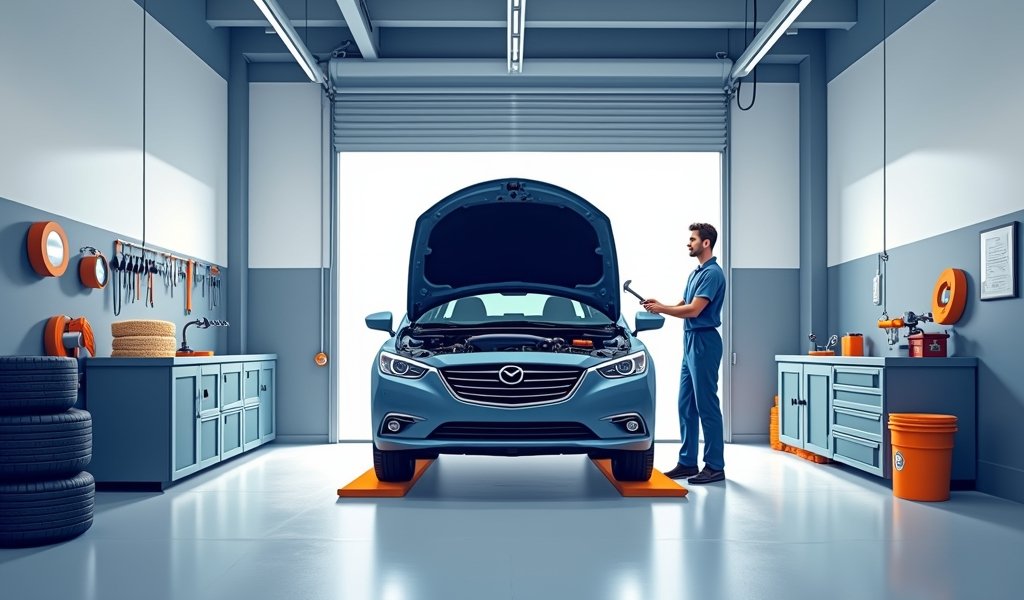Overview
This article presents seven essential car maintenance tips from an experienced mechanic to help drivers save money, including regular oil changes, proper tire care, fluid checks, air filter replacement, battery maintenance, brake servicing, and inspecting belts and hoses. Each recommended maintenance task is described as a cost-effective way to prevent expensive repairs while extending vehicle lifespan, with the overall message that proactive maintenance is both financially prudent and safety-conscious.
Table of Contents
- Introduction to Affordable Auto Service
- Tip 1: Regular Oil Changes on Schedule
- Tip 2: Proper Tire Maintenance
- Tip 3: Regular Fluid Checks and Top-offs
- Tip 4: Air Filter Replacement
- Tip 5: Battery Care and Testing
- Tip 6: Basic Brake Maintenance
- Tip 7: Inspecting Belts and Hoses
- Conclusion
- Frequently Asked Questions
Introduction to Affordable Auto Service
As a mechanic with over 15 years in the field, I’ve seen too many costly repairs that could have been avoided with simple maintenance. Affordable auto service isn’t just about finding the cheapest shop in town—it’s about preventing expensive problems before they start. Think of your car like your body: regular check-ups are far less painful (and less expensive) than emergency surgery.
The average driver spends about $1,200 annually on vehicle maintenance and repairs, but with the right preventative approach, you could cut that figure by 30% or more. In today’s economy, who doesn’t want to save a few hundred dollars while extending their vehicle’s lifespan?
What makes affordable auto service truly accessible isn’t just the price tag—it’s understanding which maintenance tasks deliver the biggest bang for your buck. I’ve compiled seven proven maintenance tips that strike the perfect balance between necessity and cost-effectiveness. These aren’t just random suggestions; they’re the same recommendations I give to my family members when they’re trying to keep their vehicles running smoothly without breaking the bank.
Tip 1: Regular Oil Changes on Schedule
If there’s one cornerstone of affordable auto service, it’s timely oil changes. Your engine has hundreds of moving metal parts all working together in a precisely choreographed dance—oil is what keeps them from grinding each other into expensive metal shavings. I’ve rebuilt engines that failed simply because someone stretched their oil change interval too far, turning a $50 maintenance task into a $4,000 rebuild.
For most modern vehicles, changing your oil every 5,000-7,500 miles is sufficient, though always check your owner’s manual for the manufacturer’s recommendation. Many newer vehicles have oil life monitoring systems that take your driving habits into account. If you’re comfortable doing it yourself, performing your own oil change can save you $25-$45 each time.
When choosing oil, don’t automatically reach for the most expensive synthetic option. While synthetics offer excellent protection, many vehicles run perfectly fine on conventional oil if changed at proper intervals. The key factors to look for include:
- The correct viscosity (weight) as specified in your owner’s manual
- An API certification symbol on the bottle
- The right oil for your climate (thinner oils for colder regions)
One common misconception I hear in my shop is that dark oil means it needs changing immediately. Oil naturally darkens as it does its job collecting contaminants—that’s normal! Follow your recommended intervals rather than judging by color alone. According to Edmunds automotive experts, oil analysis shows most modern oils maintain their protective properties well beyond the point they turn dark.

Tip 2: Proper Tire Maintenance
I can’t tell you how many customers come in for expensive repairs that started with neglected tires. Proper tire maintenance is perhaps the most underrated aspect of affordable auto service. Your tires are literally where the rubber meets the road—they affect everything from fuel efficiency to braking distance to ride comfort.
Checking your tire pressure monthly takes less than five minutes but can improve your gas mileage by up to 3%, according to the U.S. Department of Energy. That might not sound like much, but it adds up to real savings over a year of driving. The correct pressure isn’t what’s stamped on the tire sidewall—that’s the maximum pressure. Look for a sticker inside your driver’s door jamb or in your owner’s manual for the correct specification.
Regular tire rotation every 5,000-7,500 miles ensures even wear and maximizes tire life. If you’re already getting an oil change at a shop, many places will rotate your tires for a nominal fee or even for free. This simple maintenance step can extend tire life by thousands of miles—potentially saving you hundreds of dollars over time.
Don’t forget about wheel alignment. If your vehicle pulls to one side or you notice uneven tire wear, you likely need an alignment. While this service typically costs $75-150, it prevents premature tire wear that could cost much more in early tire replacement. Signs you might need an alignment include:
- Vehicle pulling to one side during straight driving
- Uneven tire wear patterns (particularly on the edges)
- Steering wheel not centered when driving straight
- Squealing tires when taking corners
For tire longevity, I also recommend the “penny test” to check tread depth. Insert a penny with Lincoln’s head upside down into your tire groove—if you can see the top of his head, it’s time for new tires. Adequate tread depth isn’t just about tire life; it’s about your safety, especially in wet conditions.
Tip 3: Regular Fluid Checks and Top-offs
Your vehicle relies on several different fluids to operate properly, and checking them regularly is a cornerstone of affordable auto service. I’ve seen $15 fluid top-offs prevent $1,500 repairs more times than I can count. The great news? Checking most fluids is something almost anyone can do with minimal tools and knowledge.
Start with coolant (antifreeze), which prevents your engine from overheating and freezing. Check your coolant level only when the engine is cool by examining the overflow reservoir—it should be between the “min” and “max” lines. Modern coolants typically last 5 years or 100,000 miles, but checking the level monthly can help you spot leaks before they become serious problems.
Transmission fluid is another critical fluid that many people overlook. For vehicles with a dipstick (becoming less common in newer models), check the fluid with the engine running and transmission in park. The fluid should be bright red to light brown and shouldn’t smell burnt. Dark or burnt-smelling fluid indicates it’s time for a change—a $150-300 service that can prevent a $3,000+ transmission replacement.
Power steering fluid, brake fluid, and windshield washer fluid should also be checked regularly. Low brake fluid, in particular, could indicate worn brake pads or a leak in the system. If you notice your brake fluid reservoir consistently low, it’s time to find a reliable service center to inspect your brake system.
One fluid check that’s often overlooked is the differential fluid (for rear-wheel or four-wheel drive vehicles). While this typically needs changing less frequently (every 30,000-60,000 miles), neglecting it can lead to expensive differential repairs. According to Car and Driver research, differential fluid service costs around $75-150 but can prevent repairs costing ten times as much.
Tip 4: Air Filter Replacement
Your engine breathes through its air filter, and just like your own breathing, restriction leads to poor performance. A clean air filter is crucial for efficient combustion, and fortunately, it’s one of the easiest and most affordable maintenance tasks you can perform. I’ve seen vehicles gain noticeable pep and improved fuel economy from simply replacing a severely clogged filter.
Most air filters should be replaced every 15,000-30,000 miles, but this varies based on your driving conditions. If you frequently drive on dusty roads or in high-pollution areas, more frequent replacement may be necessary. The good news is that checking your filter takes seconds—just open the air box (usually a large plastic container near the front of the engine bay secured with clips or screws) and hold the filter up to a light source.
If light passes easily through the filter, it’s still good. If light is significantly blocked, it’s time for a replacement. A new engine air filter typically costs $15-30 for the part, and most people can replace it themselves in under five minutes with no special tools required. Shops often charge $30-50 for this service, so this is an ideal DIY car repair that saves money.
Don’t forget about your cabin air filter, which keeps the air inside your vehicle clean. This filter typically needs replacement every 15,000-25,000 miles and is usually located behind the glove compartment in most vehicles. Symptoms of a clogged cabin filter include:
- Reduced airflow from vents
- Unusual odors when using climate control
- Increased fogging of windows
- More dust accumulation inside the vehicle
Replacing both your engine and cabin air filters regularly not only improves performance and comfort but can also prevent more expensive issues down the road. A clogged engine air filter forces your engine to work harder, potentially reducing fuel economy by up to 10% according to U.S. Department of Energy data.

Tip 5: Battery Care and Testing
Nothing ruins your day quite like a car that won’t start, and the battery is usually the culprit. In my years as a mechanic, I’ve rescued countless stranded drivers who could have avoided the hassle with simple battery maintenance. The good news is that basic battery care is straightforward and can significantly extend battery life.
Most car batteries last 3-5 years, but proper maintenance can push them toward the longer end of that range. Start by keeping the battery terminals clean—corrosion (that white or blue-green crusty stuff) increases resistance and makes your battery work harder. A simple mixture of baking soda and water applied with an old toothbrush works wonders for cleaning terminals, just be sure to disconnect the battery first (negative terminal first, then positive).
Many auto parts stores offer free battery testing—take advantage of this service twice a year, especially before extreme temperature seasons. Temperature extremes are hard on batteries, with summer heat actually causing more damage while winter cold just makes existing problems more apparent. If your battery is over three years old and shows signs of weakness during testing, consider proactive replacement rather than waiting for a failure.
For those comfortable with basic tools, checking battery voltage at home is simple. A healthy battery should read about 12.6 volts when the engine is off and 13.7-14.7 volts when running. Inexpensive digital multimeters cost around $15-20 and can help you monitor battery health.
One often overlooked aspect of battery maintenance is addressing parasitic drains—electrical draws that occur when your vehicle is off. If you notice your battery frequently dying after the car sits for a few days, you might have an excessive parasitic drain that needs diagnosis. Common causes include:
- Trunk, glove box, or dome lights that don’t turn off properly
- Aftermarket electronics with poor wiring
- Computer modules that aren’t entering sleep mode correctly
- Bad alternator diodes
Addressing these issues promptly can save you from repeatedly buying new batteries or finding yourself stranded at inconvenient times.
Tip 6: Basic Brake Maintenance
When it comes to affordable auto service, brake maintenance offers perhaps the best value proposition—relatively inexpensive maintenance prevents extremely expensive repairs (not to mention safety issues). As someone who’s worked on thousands of brake systems, I can tell you that most major brake problems start as minor issues that were ignored.
Learn to listen to your brakes—they’ll tell you when they need attention. Squealing or grinding noises, vibration during braking, or a soft/spongy brake pedal all indicate problems that should be addressed promptly. Replacing brake pads when they first begin to make noise typically costs $150-300 per axle, but waiting until you hear grinding can add rotors to the job, potentially doubling the cost.
Visually inspecting your brake pads is easier than most people realize. On many vehicles, you can see the brake pad material by looking through the wheel spokes at the caliper. You should see at least 1/4 inch of pad material. If it looks thin or you can see the metal backing plate, it’s time for replacement.
Brake fluid should be checked regularly and changed every 2-3 years. Over time, brake fluid absorbs moisture from the air, which lowers its boiling point and can lead to brake fade during hard stops. Fresh brake fluid is typically amber in color—if yours is dark brown or black, it’s overdue for replacement.
A simple habit that can extend brake life is proper driving technique. Hard, last-second braking wears pads much faster than gradual stopping. By looking ahead and anticipating stops, you’ll not only save your brakes but also improve fuel economy. Some additional brake-saving tips include:
- Avoid “riding” the brakes on downhill stretches
- Remove unnecessary weight from your vehicle
- Use engine braking (downshifting) when appropriate
- Don’t drive with your left foot resting on the brake pedal
Regular brake maintenance isn’t just about saving money—it’s about safety. According to the National Highway Traffic Safety Administration, brake failures contribute to approximately 22% of mechanical-failure crashes. That makes proper brake maintenance both a financial and safety priority.
Tip 7: Inspecting Belts and Hoses
If there’s a category of car parts that follows the “an ounce of prevention equals a pound of cure” rule perfectly, it’s belts and hoses. These relatively inexpensive rubber components can cause catastrophic damage when they fail. I’ve seen $30 belts lead to $2,500 engine repairs when they break at highway speeds.
Modern serpentine belts last much longer than the V-belts of yesteryear, typically going 60,000-100,000 miles. However, they don’t always show obvious signs of wear before failing. Look for cracks, fraying edges, or glazed/shiny surfaces. If your belt is more than five years old, consider replacement even if it looks okay—rubber compounds deteriorate with time and heat exposure.
Hoses, particularly coolant hoses, should be checked for soft spots, bulging, or cracking. A failed coolant hose can cause your engine to overheat in minutes, potentially leading to warped cylinder heads or even a cracked block. Gently squeeze coolant hoses when the engine is cool—they should feel firm but slightly flexible. Excessively soft spots indicate internal breakdown.
Timing belts (found on many but not all engines) are particularly critical. Unlike serpentine belts, timing belts are hidden behind covers and can’t be visually inspected during routine maintenance. Most manufacturers recommend replacement every 60,000-100,000 miles. While timing belt replacement isn’t cheap ($500-1,000 for most vehicles), it’s far less expensive than the engine damage that can occur if it breaks. Many “interference” engines will suffer bent valves or worse if the timing belt fails.
When having belts or hoses replaced, consider these companion services:
- Have tensioners and pulleys inspected when replacing a serpentine belt
- Replace the water pump when doing timing belt service (they often have similar lifespans)
- Check for leaks at hose connections and replace clamps if needed
- Consider a cooling system flush when replacing coolant hoses
By staying proactive with belt and hose inspections, you can often schedule replacements at convenient times rather than facing unexpected breakdowns. This approach epitomizes affordable auto service—spending wisely on maintenance to avoid costly emergency repairs.
Conclusion
Affordable auto service isn’t about cutting corners—it’s about making smart investments in your vehicle’s health that pay dividends in reliability and longevity. Each of the seven maintenance tips we’ve covered represents a strategic approach to car care that balances cost against potential problems.
Remember that the most expensive repairs often result from neglected maintenance. A $30 oil change prevents a $3,000 engine rebuild. A $150 brake pad replacement avoids a $500 rotor replacement plus brake pads. A $20 air filter helps maintain optimal fuel economy, saving money with every mile driven.
The beauty of these affordable auto service tips is that many can be performed as DIY projects, even for those with limited mechanical experience. For tasks beyond your comfort zone, building a relationship with a trustworthy mechanic pays off. A good technician won’t just fix problems—they’ll help you prevent them.
By implementing these seven proven maintenance strategies, you’re not just saving money today—you’re protecting your investment for the road ahead. Your vehicle will reward your attention with fewer surprises, better performance, and a much healthier relationship with your bank account.
Frequently Asked Questions
How often should I really change my oil for affordable auto service?
For most modern vehicles, every 5,000-7,500 miles is sufficient. Always check your owner’s manual for the manufacturer’s specific recommendation for your model.
Can I save money by doing my own car maintenance?
Absolutely—DIY tasks like oil changes, air filter replacements, and basic fluid checks can save you hundreds annually. Start with simple maintenance before attempting more complex repairs.
What’s the most important fluid to check regularly?
Engine oil level is the most critical, as running low can cause catastrophic engine damage. Check it at least monthly or before any long trip.
How do I know if a mechanic is charging fair prices?
Get written estimates from multiple shops and research typical costs online for your specific repair. Reputable shops will explain their pricing and won’t pressure you into immediate repairs.
What’s one car maintenance task people overlook that costs them money?
Tire pressure checks are frequently overlooked yet affect fuel economy, tire wear, and safety. Checking monthly can save up to 3% on fuel costs and extend tire life significantly.


Pingback: tesla maintenance cost: 5 Essential Tips - knowsyourcar.com